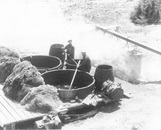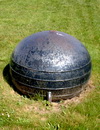|
The Bark Pot, also known as Bark Kettle, was a large iron cauldron used by fishermen in the making of a preservative used to treat fishing gear. Buds and bark from a spruce, fir, or other conifer tree would be placed in the bark pot. After filling the pot with water, a fire was then lit and the solution was boiled for several hours. Schooner sails and fishing nets were placed in the bark pot and immersed in the bark mixture. Following the initial boil period of approximately half an hour, the nets or sails were removed from the pots, placed on hand bars, and carried to fences, rocks or wharfs where they were spread out to dry. The dark liquid contained small amounts of myrrh and turpentine derived from the buds and bark and helped preserve the twines from the mildew and corrosive effects of sea water. Barked nets and sails were less prone to attacks by airborne fungi, bacteria, and marine organisms and therefore held a greater resistance to rot. The barking method was also used to treat the sealskin used in the making of boots. In the early 1800s, fishermens’ clothing was commonly constructed of whitney – a barked swanskin (also known as “swansdown”, a thick, woolly, creamy-white cloth used for making clothes, especially, coats, drawers, mitts, and buskins). Barked burlap was commonly used in the traditional hooked rug. The barking process turned the burlap to a very dark brown color that was versatile in the various patterns and designs of hooked rugs. The Twillingate Museum holds two bark pots as part of its extensive collection. Now used as a garden ornament and flower planter, the two bark pots are a unique feature of the picnic area surrounding the Twillingate Museum. The Archives feature digitized photographs of early barking methods. |


